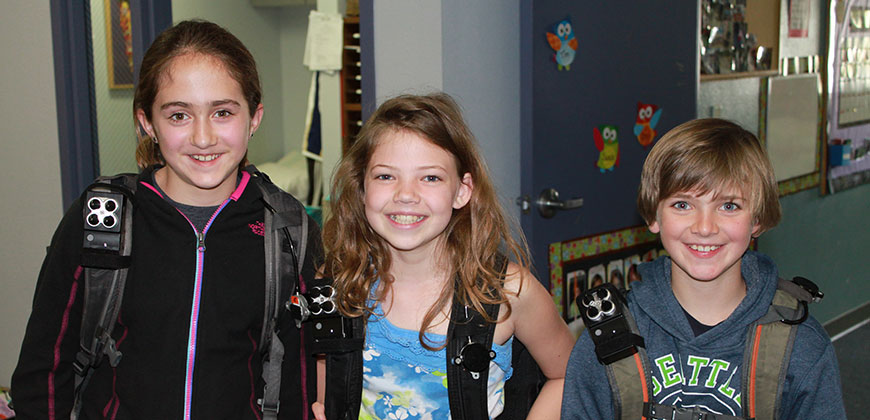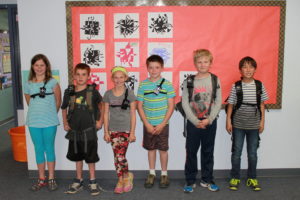
Rivendell School students Ella Zuellig, Logan Lynxwiler and Lincoln Frost are among those helping CSU researchers pilot-test wearable air pollution monitors.
For the next week, about 25 students at the Rivendell School in Fort Collins are wearing some unusual accessories – little black devices that look a bit like old digital cameras.
The accessories are wearable air pollution monitors created by Colorado State University scientists. The fourth- and fifth-graders are helping test the monitors, which could eventually aid asthma sufferers in combating the effects of poor air quality.

The CSU research team is led by John Volckens, associate professor in the Department of Mechanical Engineering, and Chuck Henry, professor and chair in the Department of Chemistry. Supported by the National Institutes of Health, the researchers are seeking to deploy low-cost, wearable air pollution sensor technology. Their goal is to determine the air quality in personal microenvironments (i.e. home, school, transit), to help asthma sufferers and other vulnerable populations get more information on what they’re breathing to prevent attacks.
“A low-cost monitor that a kid could wear could have huge public health benefits,” said study collaborator Sheryl Magzamen, assistant professor in CSU’s Department of Environmental and Radiological Health Sciences. “If parents know where their child’s risks from air pollution exposure are greatest, then they can make changes based on that information. This technology will hopefully empower those sorts of actions.”
The researchers are piloting their monitors in partnership with students, teachers and parents at Rivendell School, a private pre-K-6 school in Fort Collins. Through May 23, the students will voluntarily wear the sensors and report their experiences with them. “We’ve learned that you can’t just show up and throw technology at people,” Volckens said. “You have to find out what drives their decisions and motivations about the tech.”
Answering consumer questions
They hope the pilot will answer questions like: Does the technology even work? Do the kids like it?
“The kids are playing the role of both scientist and customer,” Volckens said. “They are helping us collect cutting-edge data on air pollution. And with their feedback, we can make changes that make the sensors less obtrusive. Maybe they’re too noisy or heavy, or the light bothers them when they go to sleep. All these questions can only be answered by people using them.”
So far, the students have seemed to enjoy working with CSU and have provided valuable feedback to the researchers.
“I think it’s interesting that CSU is working on how pollution affects asthma and can measure it with this device,” said Rivendell student Owen Terpstra.
“It has been an incredible opportunity for the students to experience real-life science and engineering,” added teacher Lori Wold.
STEM in everyday life
This highlights another aspect of the research: The scientists want to drum up awareness about their project, and possibly get individual volunteer students interested in learning more about air pollution and the role of STEM disciplines in their everyday lives.
Following the Fort Collins pilot, the researchers will launch a second pilot in Fresno, Calif. – one of the country’s most polluted cities. After that, if the technology works, they plan to deploy the sensors on hundreds of children with asthma to help understand how their surrounding environment plays a role in their health.
Key to the project is keeping the technology low-cost. To do it, they’re borrowing existing, off-the-shelf components inspired by the growing DIY electronics community. All of the user experience technology embedded in the devices – light sensors, cameras, screens and batteries – are all preexisting parts that the researchers have culled together.
The devices use micropumps that collect air samples over the course of a day to estimate exposure to harmful forms of particulate matter like smoke and dust. Data is stored via flash memory, and Bluetooth receivers can send data remotely to a mobile phone app.
“Our technology is based upon the same technology found in state and federal air pollution monitoring networks, but is much more cost effective and more appropriate for personal air sampling,” said Casey Quinn, a Ph.D. student leading the field study.
For the air pollution project, the researchers have received two separate grants. The first, awarded in spring 2015, was to develop the technology for kids with asthma. The other grant, awarded last fall, supports the deployment of the technology on workers in dusty trades, such as construction, agriculture and mining.
Volckens and Magzamen are members of the Colorado School of Public Health.